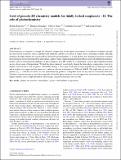Files in this item
Grid of pseudo-2D chemistry models for tidally locked exoplanets – II. The role of photochemistry
Item metadata
| dc.contributor.author | Baeyens, Robin | |
| dc.contributor.author | Konings, Thomas | |
| dc.contributor.author | Venot, Olivia | |
| dc.contributor.author | Carone, Ludmila | |
| dc.contributor.author | Decin, Leen | |
| dc.date.accessioned | 2022-04-12T11:31:35Z | |
| dc.date.available | 2022-04-12T11:31:35Z | |
| dc.date.issued | 2022-06 | |
| dc.identifier | 278900618 | |
| dc.identifier | 0026ed1e-f245-4972-866d-d2ff9a404417 | |
| dc.identifier | 000779888800006 | |
| dc.identifier | 85128721813 | |
| dc.identifier.citation | Baeyens , R , Konings , T , Venot , O , Carone , L & Decin , L 2022 , ' Grid of pseudo-2D chemistry models for tidally locked exoplanets – II. The role of photochemistry ' , Monthly Notices of the Royal Astronomical Society , vol. 512 , no. 4 , pp. 4877–4892 . https://doi.org/10.1093/mnras/stac809 | en |
| dc.identifier.issn | 0035-8711 | |
| dc.identifier.other | Jisc: 221389 | |
| dc.identifier.uri | https://hdl.handle.net/10023/25174 | |
| dc.description | Funding: RB acknowledges funding from a PhD fellowship of the Research Foundation – Flanders (FWO). OV acknowledges support from the Agence Nationale de la Recherche (ANR), through the project EXACT (ANR-21-CE49-0008-0) and from the CNRS/INSU Programme National de Planétologie (PNP). This work was supported by CNES, focused on the EXACT project and Ariel. LC acknowledges support from the DFG Priority Programme SP1833 Grant CA 1795/3 and the UK Royal Society Grant URF R1 211718. LD acknowledges support from the FWO research grant G086217N. RB, TK, and LD acknowledge support from the KU Leuven IDN/19/028 grant ESCHER. | en |
| dc.description.abstract | Photochemistry is expected to change the chemical composition of the upper atmospheres of irradiated exoplanets through the dissociation of species, such as methane and ammonia, and the association of others, such as hydrogen cyanide. Although primarily the high altitude day side should be affected by photochemistry, it is still unclear how dynamical processes transport photochemical species throughout the atmosphere, and how these chemical disequilibrium effects scale with different parameters. In this work we investigate the influence of photochemistry in a two-dimensional context, by synthesizing a grid of photochemical models across a large range of temperatures. We find that photochemistry can strongly change the atmospheric composition, even up to depths of several bar in cool exoplanets. We further identify a sweet spot for the photochemical production of hydrogen cyanide and acetylene, two important haze precursors, between effective temperatures of 800 and 1400 K. The night sides of most cool planets (Teff < 1800 K) are shown to host photochemistry products, transported from the day side by horizontal advection. Synthetic transmission spectra are only marginally affected by photochemistry, but we suggest that observational studies probing higher altitudes, such as high-resolution spectroscopy, take photochemistry into account. | |
| dc.format.extent | 16 | |
| dc.format.extent | 3670192 | |
| dc.language.iso | eng | |
| dc.relation.ispartof | Monthly Notices of the Royal Astronomical Society | en |
| dc.subject | Planets and satellites: atmospheres | en |
| dc.subject | Planets and satellites: composition | en |
| dc.subject | QB Astronomy | en |
| dc.subject | QC Physics | en |
| dc.subject | NDAS | en |
| dc.subject.lcc | QB | en |
| dc.subject.lcc | QC | en |
| dc.title | Grid of pseudo-2D chemistry models for tidally locked exoplanets – II. The role of photochemistry | en |
| dc.type | Journal article | en |
| dc.contributor.sponsor | The Royal Society | en |
| dc.contributor.institution | University of St Andrews. School of Physics and Astronomy | en |
| dc.identifier.doi | 10.1093/mnras/stac809 | |
| dc.description.status | Peer reviewed | en |
| dc.identifier.grantnumber | URF/R1/211718 | en |
This item appears in the following Collection(s)
Items in the St Andrews Research Repository are protected by copyright, with all rights reserved, unless otherwise indicated.

